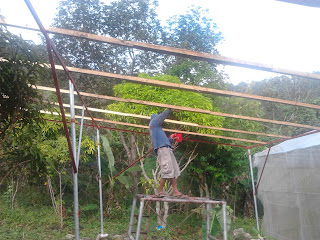 |
| Costales Nature Farms, Majayjay, Laguna. |
Gardening will always be a part of my life. I was lucky to join a group of farmers from the Cordillera Region (uplands in Northern Luzon, Philippines) in a visit to model farms last April 16 to 20, 2013. It was quite a long journey but it was worth it. Our group's first stop was at Kahariam Farms in Lipa City, Batangas. Secluded a few kilometers away from the city, the rough road opens up to a sixteen hectare farm with its signature gazebo. Kahariam Farms boasts of the only farm in South East Asia to be a certified producer of organic rice seeds. Kahariam Farms had difficulties in marketing its organically grown vegetables but eventually found gold in producing vermi (earthworm derived) fertilizer. The former horse stable now produces two hundred tons a month of organic fertilizer certified by the Fertilizer and Pesticide Authority, from composting worms. Several greenhouses and even under Mango trees are stocked with composting worms. Kahariam Farms also produces vegetables, free range chicken, colored Tilapia and provides training programs to farmers. Costales Nature Farms in cool
 |
| Engr. Ronald Costales and author. |
Majayjay, Laguna was our next day visit. Engineer Ronaled Costales introduced his company as we gathered in a thatched roof -one story conference hall. He left a telecom company as an executive vice president at age 39 and started Costales Nature Farms. Ronald never knew anything about farming but got himself prepared by attending seminars here and abroad. Today, the farm produces eight to ten tons of various vegetables each month. Costales Nature Farms has won accolades- the owner was adjudged 2012 Most Outstanding Organic Farmer of the Philippines and earned its organic certification. Last stop is Duran Farm, owned by Daisy Duran of San Ildefonso, Bulacan. Daisy, a housewife was always enterprising. She sold fish balls in her home which was near a school. She attended a seminar in vegetable production and converted her backyard into a vegetable plot. She got the surprise of her life when she earned seventy thousand pesos from her first vegetable growing venture. She never looked back since. She found her niche in seedling production, earning her the title "Seedling Queen" in several magazine articles written about her. She has then taught her neighbors how to do seedling production, virtually turning San Ildefonso, Bulacan as the vegetable
 |
| Costales Farms. |
capital of Bulacan. Daisy's life and her neighbors have changed for the better. She waxed sentimental as she told us her story, became emotional, quickly recovering with a laugh. Ever so humble, Daisy picked up her megaphone and led us on a tour of her farm, demonstrated how to propagate seeds. All three model farms were using vermi composting as source of fertilizer and reminded us of taking care of the soil. To the rest of us, we went home inspired, vowing to implement a sustainable way to raise food and help contribute to a cleaner, healthier environment.

























